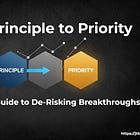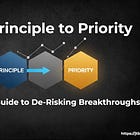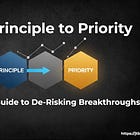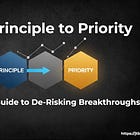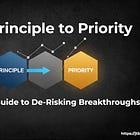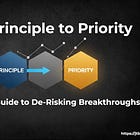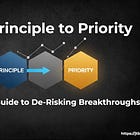From Principle to Priority: Chapter 6
The Metrics of Success: Defining Customer Success Statements
This 10-article series is designed to disrupt common thinking about innovation. It provides a new framework to help you tear down old methods and invest more efficiently in breakthrough ideas. Please share!
Part 3 (cont.)
In the previous chapter, we built our Job Map, a ten-step, solution-agnostic, chronological process that the CFO must execute to “Mitigate quantified environmental liabilities.” We transformed a single, abstract job into a discrete, tangible journey, defining the precise “where” of potential customer struggle.
But this map, while essential, is incomplete. It gives us the destinations (the steps), but not the performance criteria for the journey. We know the CFO must “LOCATE” data, but how do they judge success in that step? Is a “good” outcome one that is fast, cheap, accurate, or simple? Or all of the above?
If we were to survey 200 CFOs right now and ask them, “On a scale of 1-10, how satisfied are you with ‘Locating data’?” the results would be useless. The question is ambiguous. The data would be a statistical mush, impossible to act on.
To quantify the opportunity and find the specific, underserved needs, we must first define them with rigorous precision. We must move from the “what” (the job step) to the “how” (the metric of success).
This is the purpose of Customer Success Statements (CSS).
A Customer Success Statement is a stable, solution-agnostic metric that a Job Executor uses to judge the successful execution of a job step. It is not a feature request. It is not a “pain point.” It is a clear, directional statement of a desired outcome.
A feature request is a solution: “I need a button to export a PDF.”
A pain point is a symptom: “My reporting is slow and annoying.”
A CSS is a metric: “Minimize the time it takes to generate a final, auditable report.”
This last statement is powerful. It is pure of any solution. It is stable over time. And most importantly, it is measurable. We can ask a CFO to rate both the importance and their current satisfaction with that specific outcome.
By defining these statements for every step of our Job Map, we are effectively co-creating the “perfect specification” for a new solution, as defined entirely by the Job Executor.
To do this, we cannot be casual. Ambiguity is the enemy of innovation. We must use a strict, disciplined syntax for every CSS we create. This ensures every statement is controllable, measurable, and free of vague, subjective, or solution-biased language.
The anatomy of a perfect Customer Success Statement is:
[Direction of Improvement] + [Metric] + [Object of Control] + [Contextual Clarifier]
Let’s break this down:
[Direction of Improvement]: This is the verb that sets the goal. We use a precise, approved lexicon, primarily “Minimize” (for reducing costs, time, errors, and risks) or “Increase” (for expanding output, certainty, efficiency, and value).
[Metric]: This is the unit of measure for the improvement. This is often time, likelihood, number, frequency, or risk.
[Object of Control]: This is the specific thing we are acting upon.
[Contextual Clarifier]: This is an optional phrase that pins the statement to a specific context, ensuring it is not ambiguous.
Let’s apply this framework to our CFO’s 10-step Job Map and build the raw material for our quantitative survey. We must do this for all ten steps, but let’s focus on a few critical ones to see the system in action.
Example CSS for the Job Map: “Mitigating Quantified Environmental Liabilities”
For Step 2: LOCATE (The ability to gather all necessary operational and financial data...)
Minimize the time it takes to access operational data from non-standard, disparate systems.
Increase the confidence that all required data sources have been identified.
Minimize the number of manual data-entry steps required to capture offline data.
Reduce the likelihood of failing to locate data required for a specific regulatory disclosure.
For Step 3: PREPARE (The ability to aggregate and standardize this fragmented data...)
Minimize the time it takes to validate an aggregated data set for completeness and accuracy.
Reduce the number of manual interventions required to standardize data formats from different sources.
Increase the speed at which data errors are identified during aggregation.
Reduce the likelihood of introducing errors during the data standardization process.
For Step 5: EXECUTE (Neutralize) (The ability to source and vet verifiable, high-quality offsets...)
Increase the certainty that an offset project meets all internal and regulatory verification criteria.
Minimize the time it takes to find offset projects that match a specific risk or geographic profile.
Reduce the risk of overpaying for offsets relative to their verifiable quality.
Minimize the likelihood of purchasing offsets that are later found to be invalid or fraudulent.
For Step 7: RESOLVE (The ability to investigate and remedy any discrepancies...)
Reduce the time it takes to identify the root cause of an audit discrepancy or verification failure.
Minimize the number of steps required to re-calculate a liability based on a data correction.
Increase the speed at which a failed offset purchase can be remediated with a valid one.
This process is methodical, rigorous, and exhaustive. It is not a brainstorming session. It is an act of engineering. We repeat this for all ten steps of the Job Map, generating a final, comprehensive list of 50, 100, or even 150 unique Customer Success Statements.
This list is our “Universal Set of Needs.” It represents the entire universe of metrics the CFO uses to judge success in getting this job done.
We now have the complete, high-resolution, quantitative instrument. We have transformed a vague hunch about “carbon management” into a precise, measurable, and actionable survey.
We are now, finally, ready to talk to the market at scale.
Our Option to Explore is complete. We have paid our premium and acquired our insight. Our Option to Validate is now fully defined. The business case for this next stage is simple: we must fund a quantitative survey, built from this exact Job Map and this complete list of Customer Success Statements.
We will deploy this survey to a statistically significant sample of our target Job Executor—CFOs and their equivalents. For each of the 100+ Customer Success Statements, we will ask them two simple, brutal questions:
Importance: “How important is this outcome to you?” (Scale of 1-5)
Satisfaction: “How satisfied are you with your ability to achieve this outcome today, using any solution?” (Scale of 1-5)
With the answers to these two questions, we will have the data we need. We will be able to plug the results into a simple formula that will reveal, with statistical certainty, exactly where the market is failing. We will be able to find the unserved, critical needs. We will, in effect, generate a heatmap of the opportunity, showing us exactly where to focus our efforts and where to ignore.
We are moving from qualitative insight to quantitative proof.
Guide to the Series
I make content like this for a reason. It’s not just to predict the future; it’s to show you how to think about it from first principles. The concepts in this blueprint are hypotheses—powerful starting points. But in the real world, I work with my clients to de-risk this process, turning big ideas into capital-efficient investment decisions, every single time.
Follow me on 𝕏: https://x.com/mikeboysen
If you’re interested in inventing the future as opposed to fiddling around the edges, feel free to contact me. My availability is limited.
Mike Boysen - www.pjtbd.com
De-Risk Your Next Big Idea
Masterclass: Heavily Discounted $67
My Blog: https://jtbd.one
Book an appointment: https://pjtbd.com/book-mike
Join our community: https://pjtbd.com/join



